16 Types of Blackbirds in New York (With Pictures)
Last Updated on
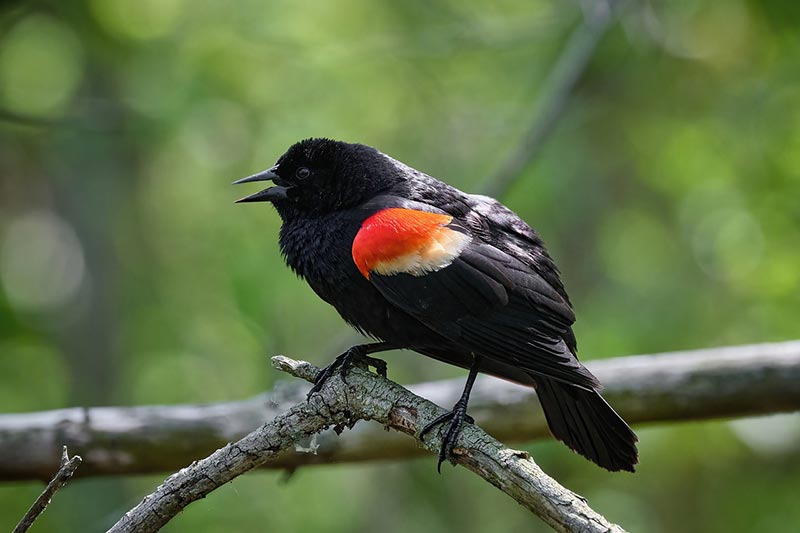
Blackbirds are a fascinating species part of the Icteridae family. In North America, these birds are called “New World Blackbirds” to differentiate them from European blackbirds. Most blackbirds are agricultural pests, but you can’t deny their beautiful and unique features.
New York is home to a wide range of blackbirds, including the Yellow-headed Blackbird, Scott’s Oriole, Common Grackle, Bobolink, and many more. Overall, you can find 16 different blackbird species in New York, so keep reading to learn about them.

The 16 Types of Blackbirds in New York:
1. European Starling

| Scientific Name | Sturnus vulgaris |
| Weight | 0.21 pounds |
| Wingspan | 15.8 inches |
| Lifespan | 3 years |
| Diet | Insects, berries, fruits, and seeds |
You can find the European Starling year-round in the wooded areas or fields of New York. Their feathers are black with a purple, iridescent glow and white edges for every feather. In simpler words, their appearance resembles a galaxy.
European Starlings have yellow beaks with black tips and red feet. These songbirds fly in noisy flocks and exhibit aggressive behavior, which is why most people consider them pests. Their diet includes holly berries, cherries, mulberries, caterpillars, flies, beetles, seeds, and grains.
These songbirds mimic other birds’ sounds, but their calls include chatter, whistles, and warbles. Their noisiness is another reason why people consider them pests. Often, these birds may also feed on sumac, Virginia Creeper, earthworms, and spiders.
European Starlings build their nests with pine needles, grass, and other soft material, laying three to six eggs that take nearly 2 weeks to hatch.
2. Red-winged Blackbird
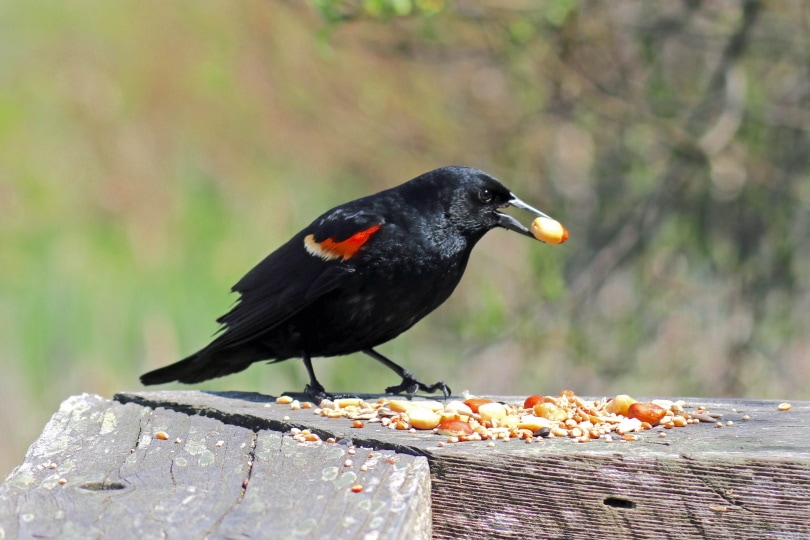
| Scientific Name | Agelaius phoeniceus |
| Weight | 0.16 pounds |
| Wingspan | 15.8 inches |
| Lifespan | 15 years |
| Diet | Seeds and suet |
Red-winged blackbirds spend their breeding season (summer) in New York before they migrate South for the winter. These birds are black except for their shoulders’ bright red and yellow patches.
Although the male Red-winged Blackbird has a striking and unique appearance, the female is plain in comparison, having a dark coloration and white eyebrows. Those searching for this blackbird can find it on telephone wires and in marshes, meadows, and fields.
Their diet consists mainly of seeds and suet in the winter and insects in the summer. If you want to identify them by sound, look for a drawn-out “okelee” song. An interesting fact about the Red-winged Blackbird is that the males defend their territories relentlessly, especially during the breeding season.
They may even attack those that come near their nests. These birds build their nests near dense vegetation with the help of stems and stalks, laying two to four eggs that take nearly 2 weeks to hatch.
3. Common Grackle
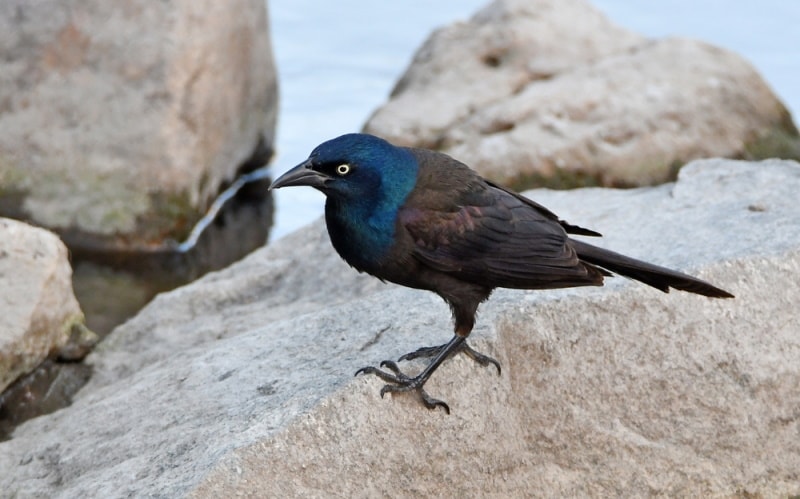
| Scientific Name | Quiscalus quiscula |
| Weight | 0.31 pounds |
| Wingspan | 18.1 inches |
| Lifespan | 22 years |
| Diet | Insects, berries, and seeds |
The Common Grackle is generally a near-threatened species, but they’re frequently spotted in New York. These birds, too, spend their summer in New York before migrating to the South for winter. Their appearance is easily identified due to the glossy, iridescent, black feather.
The blue-iridescent feathers on their head are the most striking feature, glowing luxuriously under sunlight. If you’re wondering where to find a Common Grackle in New York, marshes, parks, open woodlands, and fields are great places to look.
Although their diet consists of berries, seeds, and insects, you may also find them rummaging through the garbage for human food. Their sounds resemble whistles, croaks, and squeaks.
4. Brown-Headed Cowbird
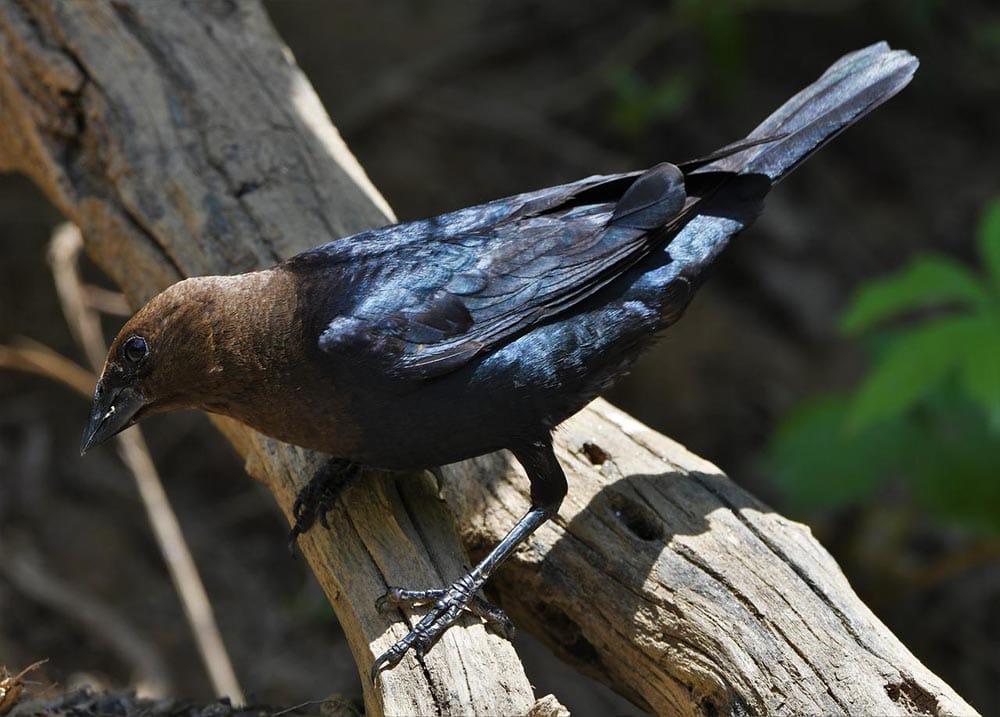
| Scientific Name | Molothrus ater |
| Weight | 0.11 pounds |
| Wingspan | 14.2 inches |
| Lifespan | 17 years |
| Diet | Seeds and insects |
The Brown-headed Cowbird has a self-explanatory appearance, consisting of a round, black body and a brown head. However, the females have a much smaller and less striking appearance, light brown with white streaks.
You may find Brown-headed Cowbirds in the wooded areas, fields, and grasslands of New York, which is why their diet consists of insects, weed seeds, grass, etc. However, the females often eat eggs (with the shell) for calcium.
Their sounds are a series of gurgles and whistles, both rapid and high-pitched, lasting only a few seconds. A strange fact about these birds is that they don’t build their nests but destroy other, smaller songbirds’ eggs to lay their own.
5. Baltimore Oriole

| Scientific Name | Icterus galbula |
| Weight | 0.08 pounds |
| Wingspan | 11.8 inches |
| Lifespan | 14 years |
| Diet | Insects, berries, and nectar |
The Baltimore Oriole embodies the phrase, “You are what you eat.” These bright orange-black birds feed on insects, berries, and nectar, including oranges, raspberries, mulberries, bananas, and cherries.
Again, the females don’t appear as striking as the males, featuring dull-orange or yellow feathers with gray accents. You can find Baltimore Orioles in the open woodlands, forest edges, and riverbanks of New York.
If you’re lucky enough, you can also attract them to your backyard or a park with some sugar water or oranges. Unfortunately, aside from their signature flute-like sounds, these birds also tend to make shrill alarm calls.
6. Bobolink

| Scientific Name | Dolichonyx oryzivorus |
| Weight | 0.12 pounds |
| Wingspan | 10.6 inches |
| Lifespan | 6 years |
| Diet | Insects and seeds. |
Bobolinks are unusual-looking birds and much easier to spot during their breeding season, which they spend in New York. The males have a jet-black body with a few white birds, but the pale-yellow patch on their heads is their most striking feature as it imitates a bald head.
Those searching for Bobolinks should look through the open grasslands of New York, where you’ll find them perched upon plants, looking for seeds and insects. Moreover, their sounds are an irregular set of check and peek calls.
7. Eastern Meadowlark
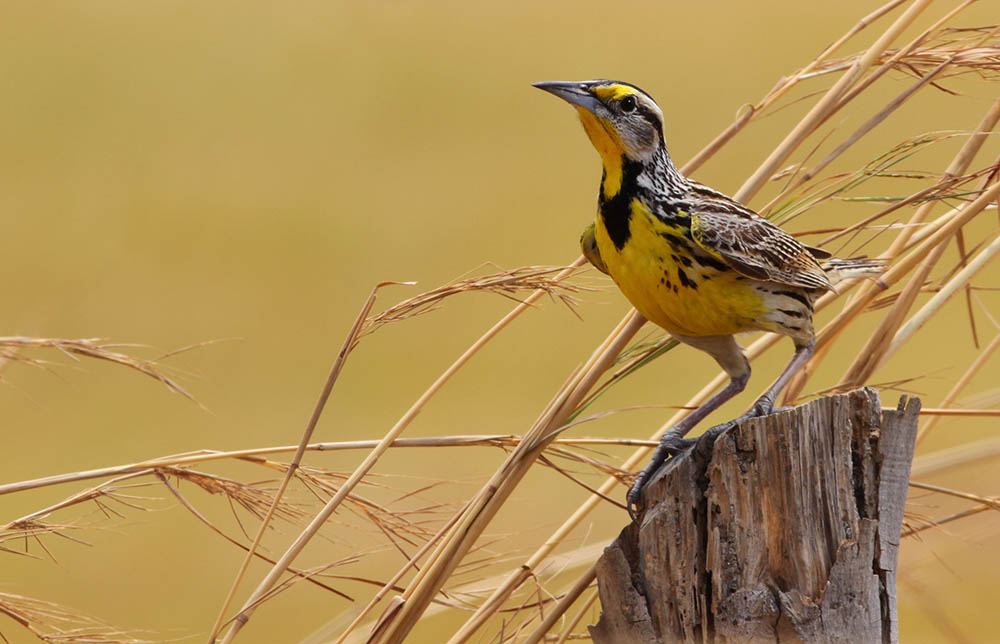
| Scientific Name | Sturnella magna |
| Weight | 0.33 pounds |
| Wingspan | 15.8 inches |
| Lifespan | 5 years |
| Diet | Seeds, waste grain, and insects |
The Eastern Meadowlark is a near-threatened species that spends the summer in New York. Their appearance is distinctive: a bright yellow belly, a black band across the chest, and a pale brown back with black marks.
When an Eastern Meadowlark starts singing, it’s clear that spring is in the air. You can find these birds in the prairies, meadows, and grasslands of New York, looking for insects, seeds, and waste grains to feed on.
Aside from their flute-like whistles being beautiful and melodious, the best part about this bird’s sounds is its ability to sing more than 100 songs.
8. Rusty Blackbird
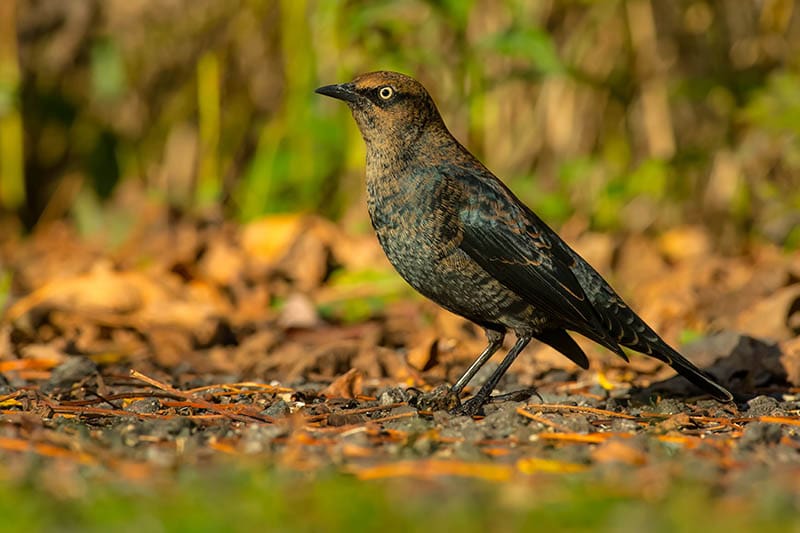
| Scientific Name | Euphagus carolinus |
| Weight | 0.17 pounds |
| Wingspan | 14.6 inches |
| Lifespan | 8 years |
| Diet | Insects and plant matter |
Rusty Blackbirds are considered a vulnerable species, spending all year in New York. These birds have a somewhat plain appearance, consisting of black feathers and rusty edges, especially in the winter.
These birds inhabit the bogs, large ponds, marshes, and swamps of New York, feeding on insects, seeds, fish, and plant matter by flipping over leaves. On occasion, they may eat other, smaller birds.
You can identify them by looking for two or three chirps followed by a high-pitched whistle.
9. Orchard Oriole
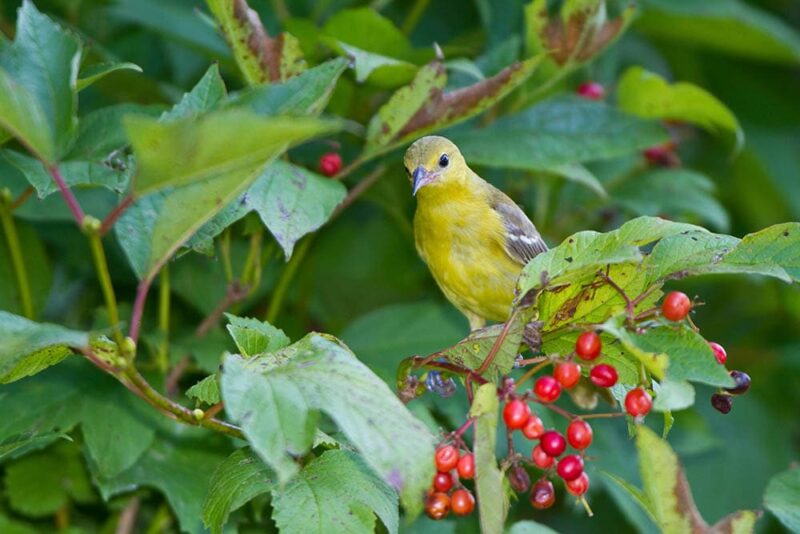
| Scientific Name | Icterus spurius |
| Weight | 0.06 pounds |
| Wingspan | 9.8 inches |
| Lifespan | 11 years |
| Diet | Insects, berries, and nectar |
The Orchard Oriole arrives in New York in April. It stays till November, but summer is the perfect time to spot them easily. The male species have bold coloring with blackheads and backs. However, female Orchard Orioles have a lime green bottom half, easily distinguishable from the male.
These birds can be found in the open woodlands, riverbanks, farms, open shrubland, and backyards of New York, building hanging pouch-like nests. Orchard Orioles prefer to feed on nectar, berries, and insects, including caterpillars, ants, beetles, and grasshoppers.
They’ll drink nectar from flowers or find chalk and mulberries if they’re lucky. Their whistles are jumbled and irregular while still melodious and lasting about 3 seconds.
10. Boat-Tailed Grackle
| Scientific Name | Quiscalus major |
| Weight | 0.55 pounds |
| Wingspan | 20 inches |
| Lifespan | 12 years |
| Diet | Grains, crayfish, aquatic insects, and snails |
If you’re looking for them in New York, Boat-tailed Grackles are typically only found on Long Island and New York City. These birds have long, glossy bodies with stretched legs, long tails, and pointed bills.
You may find these birds in parks, marshes, or beaches, looking for crayfish, snails, grains, and aquatic insects. However, they’ll eat pretty much any food scraps they find. Their sounds include repetitive “jeep” shrills with high-pitched squeaks. When alarmed, Boat-tailed Grackles tend to scream and clack.
What’s unique about these birds is that female Boat-tailed Grackles form harems, ensuring that only the highest-ranking male can mate with them.
11. Yellow-Headed Blackbird
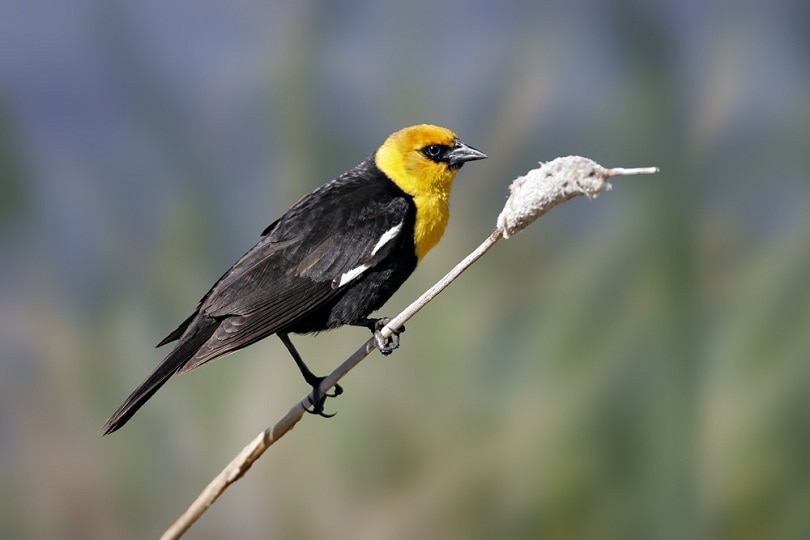
| Scientific Name | Xanthocephalus xanthocephalus |
| Weight | 0.21 pounds |
| Wingspan | 17.3 inches |
| Lifespan | 11 years |
| Diet | Insects and seeds |
The Yellow-headed Blackbird is an accidental species in New York, having glossy black feathers and a bright yellow chest and head area for the males. The females, however, have fuller shades and are brown instead of black.
You can find these birds in the prairie wetlands of New York or forage over fields, grasslands, and wetlands. Their plain diet consists of any insects and seeds they can find in such areas. Their sounds include a few chirps before a drawn-out screech.
If you want to attract a Yellow-headed Blackbird to your backyard, just place a bird feeder filled with sunflower seeds.
12. Western Meadowlark
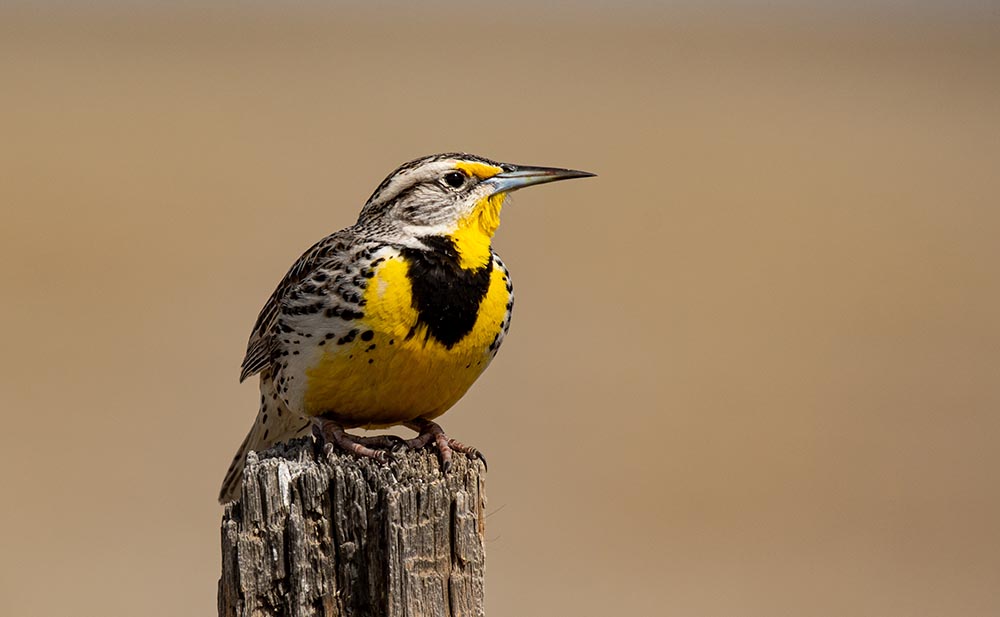
| Scientific Name | Sturnella neglecta |
| Weight | 0.25 pounds |
| Wingspan | 16.1 inches |
| Lifespan | 6 years |
| Diet | Insects and seeds |
The Western Meadowlark is another accidental species in New York, as small as a robin. These birds have black and brown upper bodies, yellow underbellies, and a black band across their chest. In the winter, this band turns gray.
You can find these birds in the meadows, fields, shrubby vegetation, wooded areas, and grasslands of New York, looking for insects, grain, and seeds to feed on. You can recognize a Western Meadowlark with its warbles, whistles, and tweets.
These birds build their nests in the depressions of grasslands, filling them with grass and creating a roof with plant stalks. You can attract these birds to your backyard with the help of cracked corn and sunflower seeds.
13. Bullock’s Oriole

| Scientific Name | Icterus bullockii |
| Weight | 0.09 pounds |
| Wingspan | 12.2 inches |
| Lifespan | 14 years |
| Diet | Insects, fruit, and nectar |
The Bullock’s Oriole is another accidental species in New York, having bright orange, black, and white feathers and more black markings on their heads. The females don’t have the same vibrancy, featuring gray backs, yellow heads, and an overall duller appearance.
You can find these birds in parks and open woodlands, feeding on insects, fruits, and nectar. Their sounds include whistles and cheeps lasting a few seconds. Moreover, Bullock’s Orioles take 15 days to build their nests with the help of wool, grass, and hair.
If you want to attract a Bullock’s Oriole to your backyard, just leave out some jelly, fruit, or sugar water.
14. Scott’s Oriole

| Scientific Name | Icterus parisorum |
| Weight | 0.08 pounds |
| Wingspan | 12.6 inches |
| Lifespan | 5 years |
| Diet | Insects, berries, and nectar |
Again, Scott’s Oriole is an accidental species in New York, having a very distinctive appearance. These birds have a black head, bright yellow underside, and black back for the male. The female, however, has an olive-brown back and a pale yellow appearance.
These birds spend their breeding season in the summer and migrate to the South for the winter. Those that want to see Scott’s Orioles in person should look for high slopes in arid areas. You’ll find these birds perched in search of insects, berries, and nectar.
However, they may also feed on toxic monarch butterflies, making sure only to eat the ones with the least toxins. Sugar water, oranges, and jelly attract these birds to your backyard.
You may also find them on yuccas as they like to sing before dawn, consisting of an articulate series of whistles. These birds like building their nests 5–7 feet above the ground with the help of yucca leaves, grass, and cactus fibers.
15. Brewer’s Blackbird
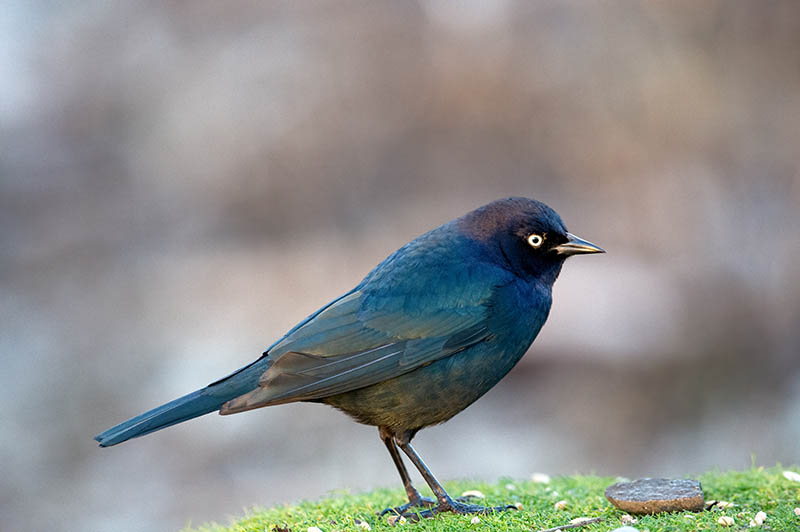
| Scientific Name | Euphagus cyanocephalus |
| Weight | 0.18 pounds |
| Wingspan | 14.6 inches |
| Lifespan | 12 years |
| Diet | Insects, berries, and seeds |
The Brewer’s Blackbird is the rarest blackbird you can find in New York, last spotted in 2014. These medium-sized birds have glossy black feathers, with the males featuring a purple patch and iridescent green glow and the females being brown all over.
Grasslands, meadows, coasts, fields, marshes, woodlands, parks, and backyards in New York feed on anything they find, such as insects, berries, and seeds. These birds build their nests with the help of grass and twigs, lined with mud and soft dry grass.
Brewer’s blackbirds tend to make “chuk” sounds with short and shrill songs. If you want to attract them to your backyard, place some cracked corn, millet, or hulled sunflower seeds in your ground feeders.
16. Bronzed Cowbird

| Scientific Name | Molothrus aeneus |
| Weight | 0.16 pounds |
| Wingspan | 13.0 inches |
| Lifespan | 8 years |
| Diet | Seeds and insects. |
The Bronzed Cowbird is also extremely rare and accidental in New York, last spotted in 2015. These birds are bigger than the typical cowbird, having dark and glossy blue wings, red eyes, and stark-black bodies.
If you want to spot a Bronzed Cowbird, you can find them in pastures, open fields, or wooded areas, feeding on seeds and insects. Their songs consist of harsh jeeps or screams and chatter when they’re alarmed.
These birds do not build nests, lay eggs in other species’ nests, and do not look after their young.

Final Thoughts
Out of these 16 blackbird species, most are recognized as regularly occurring, while others are rare and near threatened in New York. Now that you’ve read our guide on the types of blackbirds in New York, you can easily identify the ones you come across or even attract them to your backyard with the right feed.
Featured Image Credit: Howard Walsh, Pixabay
Table of Contents
- The 16 Types of Blackbirds in New York:
- 1. European Starling
- 2. Red-winged Blackbird
- 3. Common Grackle
- 4. Brown-Headed Cowbird
- 5. Baltimore Oriole
- 6. Bobolink
- 7. Eastern Meadowlark
- 8. Rusty Blackbird
- 9. Orchard Oriole
- 10. Boat-Tailed Grackle
- 11. Yellow-Headed Blackbird
- 12. Western Meadowlark
- 13. Bullock’s Oriole
- 14. Scott’s Oriole
- 15. Brewer’s Blackbird
- 16. Bronzed Cowbird
- Final Thoughts
About the Author Jeff Weishaupt
Jeff is a tech professional by day, writer, and amateur photographer by night. He's had the privilege of leading software teams for startups to the Fortune 100 over the past two decades. He currently works in the data privacy space. Jeff's amateur photography interests started in 2008 when he got his first DSLR camera, the Canon Rebel. Since then, he's taken tens of thousands of photos. His favorite handheld camera these days is his Google Pixel 6 XL. He loves taking photos of nature and his kids. In 2016, he bought his first drone, the Mavic Pro. Taking photos from the air is an amazing perspective, and he loves to take his drone while traveling.
Related Articles:
Monocular vs Telescope: Differences Explained (With Pictures)
How to Clean a Refractor Telescope: Step-by-Step Guide
How to Clean a Telescope Eyepiece: Step-by-Step Guide
How to Clean a Rifle Scope: 8 Expert Tips
What Is a Monocular Used For? 8 Common Functions
How to Clean a Telescope Mirror: 8 Expert Tips
Brightfield vs Phase Contrast Microscopy: The Differences Explained
SkyCamHD Drone Review: Pros, Cons, FAQ, & Verdict
